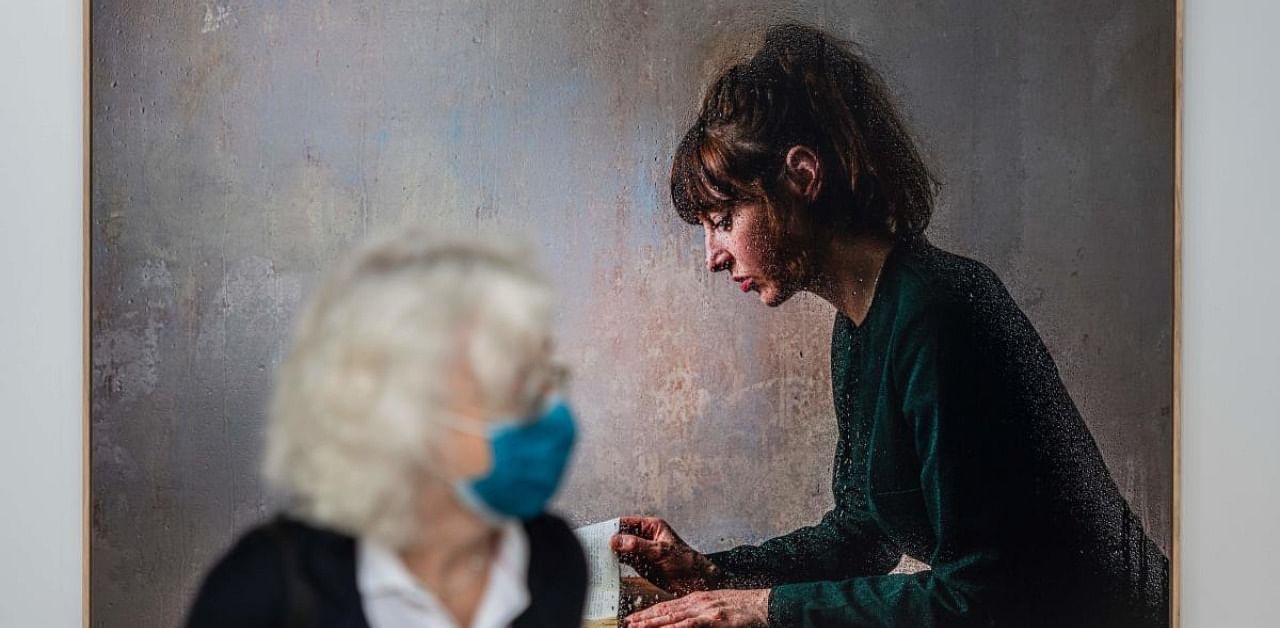
While many California museums are still shuttered because of the coronavirus, and others are opening slowly at limited capacity, the Institute of Contemporary Art San José has come up with an ingenious solution to open the museum, legally, for four days.
From October 31 through Election Day, the museum will become a polling site. Alison Gass, the executive director, is hoping civic-minded citizens will stream through the museum to vote and take time to appreciate the art inside (an exhibition called “Personal Alchemy”) and out.
It will be hard not to notice.
A 50-foot vinyl mural by Iranian-born artist Amir H Fallah will wrap around the museum’s facade, and two 6-foot circular paintings of his will slowly rotate in two windows.
In his mural, titled “Remember This,” messages in vibrant colors read: “Remember my child nowhere is safe,” “They will smile to your face” and “A borderless world,” along with other text. By “child,” Fallah means his younger self — by the age of 6, he had lived in four countries (Iran, Italy, Turkey and the United States) — and his 5-year-old son.
“In America, people have a false sense of security,” he said in a recent interview.
In late July, Gass, who also is the museum’s chief curator, asked Fallah to paint a mural that addressed “the social and political conditions happening in this election and beyond.” He told her that was what he was thinking about, too. His paintings would appear outside the institute, “because we wanted a safe way for people to see art,” Gass said.
A few days later, she met with her longtime collaborator, Florie Hutchinson, who was about to become the museum’s director of external relations. Hutchinson thought of a way for more people to see Fallah’s art: Make the museum a polling place.
“Many people in the past voted at their neighbor’s garage or in retirement homes,” said Alex Padilla, California’s secretary of state. That is no longer possible. California is promoting vote by mail “as a preferred option,” Padilla said. But for those wanting to vote in person, he said, counties have become “more creative.”
Santa Clara County, of which San Jose is the county seat, will be using libraries, empty schools, City Hall council chambers, another museum and even a police department, said Paulo Chang, the county registrar of voters, election division coordinator.
As people enter the polling place, Fallah said, “I want them to think about what their vote means, how it affects everyone and everything around them.”
Fallah said his paintings for the museum are self-portraits with imagery from disparate cultures that express injustices all over the world. “This is a pretty political mural, but it doesn’t say to vote one way or another,” he added.
A US citizen, Fallah, 41, who lives in Los Angeles, said he has experienced what he calls the abuse of government power firsthand. In January 2017, when President Donald Trump closed the nation’s borders to refugees and suspended immigration from several predominantly Muslim countries, he was detained “in a basement room at Newark Airport with other brown people,” almost all of whom were citizens, he said. He said his passport was taken from him.
Fallah’s paintings reflect his fears that “the world is getting darker and darker,” he said. His concerns include “the environment, the treatment of children by ICE, racism, social injustice, an almost war with Iran for no reason,” he said.
Fallah is also designing a giveaway button that says: “Vote like your life depends on it.” That message will be on signs in city bus shelters and on streetlight poles.
“We were poised to be nimble, especially in a moment of unimaginable crisis for arts organizations,” Gass said.
The museum, which used to be called the San Jose Institute of Contemporary Art but was recently renamed, occupies a red brick, one-story building in downtown San Jose, the third-largest city in California, which Sam Liccardo, its mayor, has called “a city of immigrants.” As of 2014, 38 per cent of residents were immigrants, including an Iranian community.
“Throughout my career I’ve been drawn to art that is about politics,” such as Fallah’s work, Gass said, “in which you begin to find meaning for yourself.” She chose an artist from an underrepresented group: “artists from countries not given a big platform in American museums.” His work “is bound up in American identity and the immigrant experience,” she added, calling it “beautiful and disturbing.”